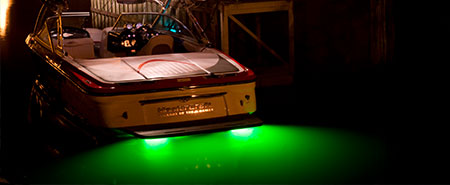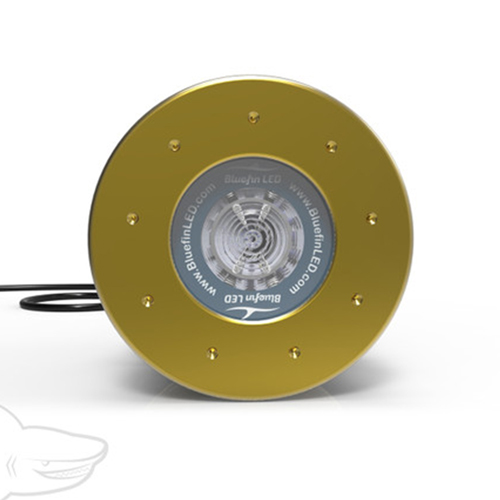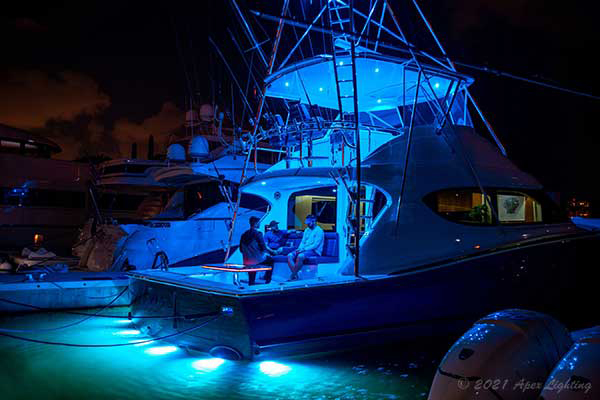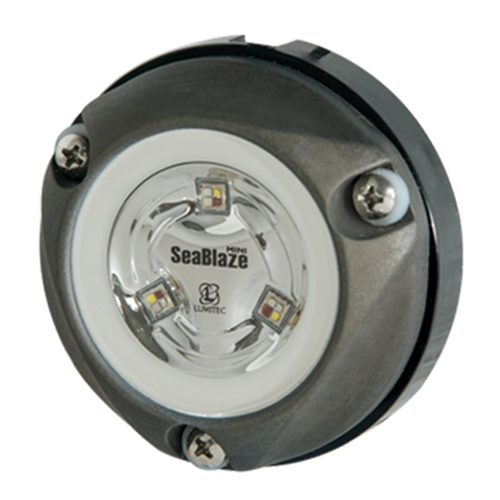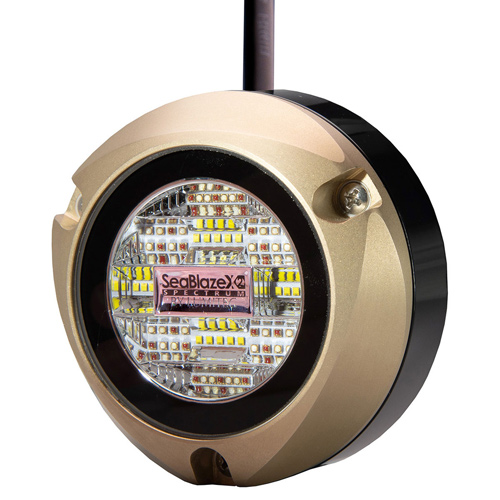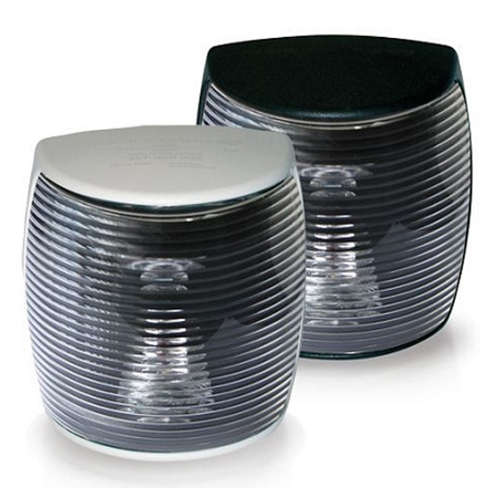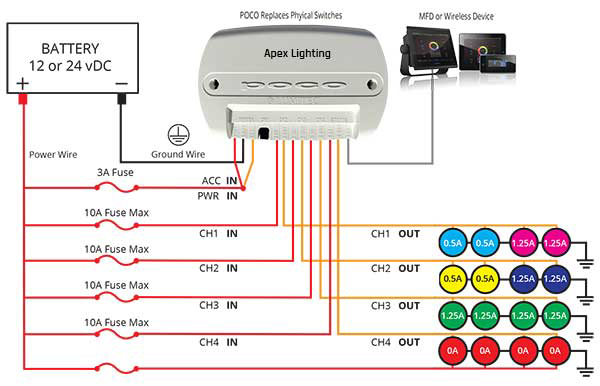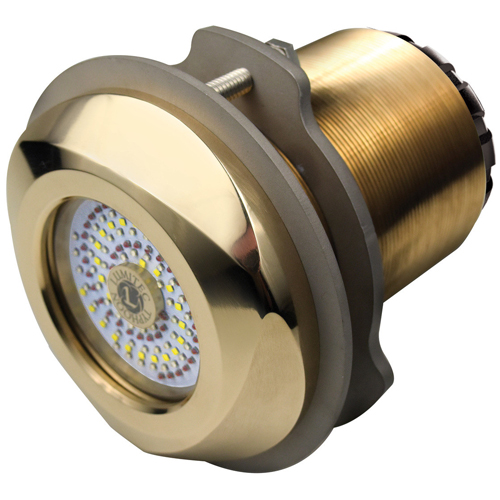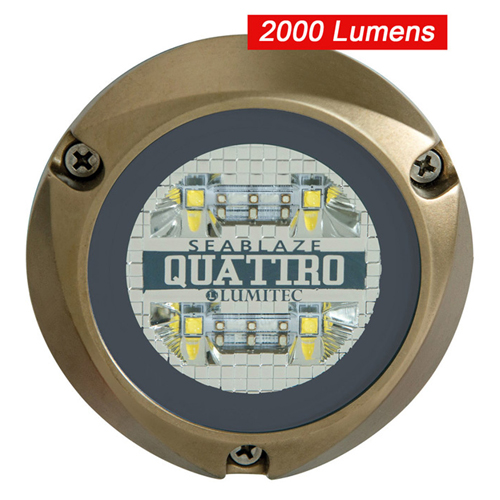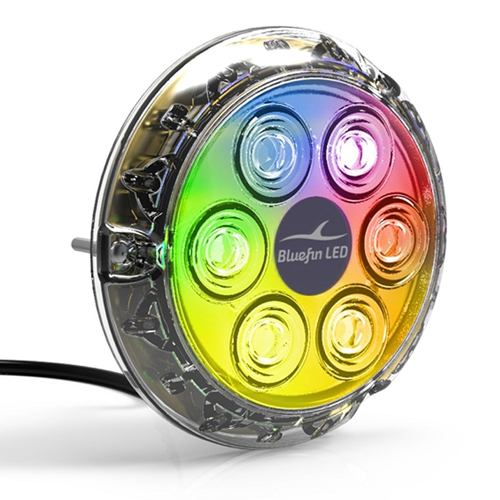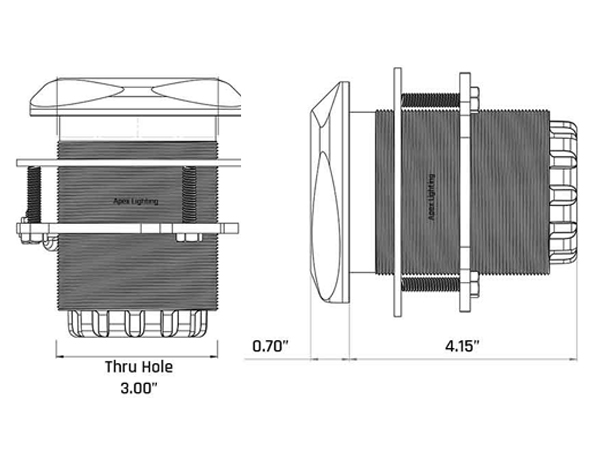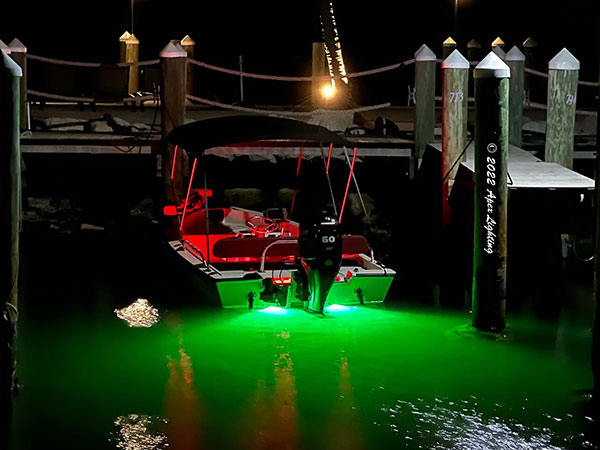Choosing the Best Underwater Lights for Your Boat: Answers to Your Frequently Asked Questions
Posted by Apex Lighting on 23rd Aug 2023
Why Do I Need Underwater Lights for My Boat?
You probably imagine underwater lights as mere cosmetic upgrades for your boat, but they’re not. These fixtures are functional additions that improve visibility under dim light conditions to ensure safe boating.
A 6,000-lumen underwater light, for instance, provides plenty of illumination to avert visibility-related mishaps such as collisions with obstacles and other vessels, especially when navigating murky waters at night.
As a secondary benefit, underwater lights enrich your boating experience by creating an alluring ambiance of color around your vessel. Chilling blues and soothing greens are just some of the options to help you set the perfect mood for a fun nighttime swim or oceanic viewing.
The green light, in particular, serves as an excellent bait for marine wildlife due to its short wavelengths of high energy that are more penetrative and visible underwater.
This improves your chances of spotting rare species, adding a layer of excitement and delight to your boating adventure.
Apex Lighting deals exclusively in top-quality brands to help you realize these benefits of underwater fixtures. The Lumitec Javelin 600X LED Underwater Light, for instance, features a full color-changing illumination of 6,000 lumens and a Color Rendering Index (CRI) of over 70.
That’s a high color resolution that’s excellent for creating an immersive underwater environment, whether you’re after a tranquil ambiance with calming colors or a dynamic atmosphere with intense hues.
What Are the Different Types of Underwater Lights?
Your options for underwater boat lights are excitingly numerous. Each selection offers different mounting styles and lighting colors to suit your taste in aesthetics and functionality, for example:
- Thru-Hull Lights - These fixtures mount from inside your boat and protrude outward from a hole, extending into the water.
As such, they appear beneath the waterline, producing a sleek underwater glow for an enchanting ambiance around your vessel. The lights are also serviceable from inside your boat and don’t require dismounting to access the internal components. - Surface Mount Lights - These fixtures mount directly on the exterior of your boat. They have a higher profile than thru-hull lights but are easier to set up as they require no drilling and subsequent sealing to prevent water intrusion.
This makes them the ideal choice for a DIY project, provided you’re trained and experienced in boat light installation. - Single-Color Lights - These specialized fixtures provide the perfect single-color illumination for specific tasks such as fishing and ocean viewing.
A single green light, for instance, has a short wavelength of high energy that’s highly penetrative through water surfaces and excellent for attracting marine life. - Color-Changing Lights - These fixtures provide the full-color spectrum of red, blue, green, and white with different light effects such as crossfades and strobes.
This makes them excellent for creating ambiance around your boat and setting the right mood for a memorable boating adventure.
“I bought two then when I got them I saw how serious they are I bought two more. Impeccable quality bright as anything on the market. I already have 5 OceanLED Pro Xtreme 16's at $1k a piece and these are brighter! You won't go wrong! I can't wait for springtime boating season.” — John, Verified Buyer
How Many Underwater Lights Do I Need for My Boat?
Determining the ideal quantity of underwater lights for your boat involves various factors, primarily, your boat's dimensions and your personal aesthetic preferences.
As a rule of thumb, it's common practice to fit a minimum of two underwater lights for small to medium-sized vessels, specifically attached to the transom.
This symmetrical setup creates a balanced illumination around the transom area, where most of the light-dependent boating activities occur, for instance, fishing and tow surfing.
Case in point, two underwater boat lights are the common design for small to medium pontoons of widths between 7–10 feet. And two fixtures, such as the Lumitec Javelin 600X Rectangular LED provide sufficient illumination when symmetrical, as the video below showcases.
Larger vessels of widths above 10 feet require more than two fixtures, however, the principle of balanced illumination still holds. As such, seeking professional advice on the spacing and exact number of fixtures your boat needs is advisable to ensure safe and adequate lighting.
What Is the Ideal Wattage for Underwater Lights?
There is no one-size-fits-all rule when it comes to the ideal wattage for underwater boat fixtures.
However, there is an efficiency standard that guides the lumen output for your fixture per watt of energy. This is known as lumen efficacy.
Therefore, determining your ideal wattage necessitates first identifying the amount of brightness you require. With this figure, you’re then able to determine the maximum allowable watt rating for that lumen output, according to today’s efficiency standards.
The table below highlights these ranges for different lumen outputs.
| Lumen Output | Maximum Watt Rating | Efficacy (Lumen/Watt) |
| 450 | 40 | 11.25 |
| 800 | 60 | 13.33 |
| 1,100 | 75 | 14.67 |
| 1,600 | 100 | 16.00 |
| 2,600 | 150 | 17.33 |
Source: Energystar.gov
Can I Install Underwater Lights by Myself or Do I Need a Professional?
Due to their submerged nature and the risks involved, including electric shocks and water intrusion, underwater boat lights require professional installation.
However, a licensed professional helps you not only observe safety guidelines to avoid all the above risks of mixing water and electricity but also ensures your installation is up to code.
One particularly critical regulation requirement for submersible devices is Ground Fault Circuit Interrupter (GFCI) protection. This mandates an automatic shutdown protocol that activates immediately an imbalance occurs, such as a current flowing through water or a person.
As such, compliance with GFCI necessitates a deep understanding of compliant devices, the setup process, and an assessment procedure after installation. These are highly specialized skills and can therefore only be executed correctly by trained and experienced individuals.
Are Underwater Lights Expensive?
Not necessarily. Underwater boat fixtures accommodate different budgets with a trade-off in the number of features and functionality available.
Certainly, the most advanced options, such as the Bluefin LED Great White GW20, cost upwards of $1,000, which is pricey. But these are top-tier fixtures with exceptional features like 12,000 lumens and an over 50,000-hour lifespan or 5.7 years of service.
There are alternative entry-level selections, such as the Lumitec Zambezi Mini Surface Mount, which costs less than $500. These fixtures offer basic features to ensure reliable service, for instance, marine-grade steel housing and full waterproofing at an affordable price point.
Midrangers, such as the Lumitec Javelin 600X LED Underwater Light, strike the perfect balance between cost and functionality by offering more than the basics without the premium pricing.
As such, they cost less than $1,000 and have extra features such as 6,000 lumens and an impressive Color Rendering Index (CRI) of over 70, which signifies a premium level of color resolution.
Want a quick summary instead? The table below provides an overview of the different categories of underwater boat fixtures, including their price ranges, examples, lumens, and typical lifespan.
| Category | Price Range | Example Fixture | Lumens Range | Typical Lifespan |
| Entry-Level | Below $500 | Lumitec Zambezi Mini Surface Mount | 1,000–3,000 | Up to 30,000 hours |
| Midrange | $500–$1,000 | Lumitec Javelin 600X LED | 4,000–7,000 | Up to 50,000 hours |
| Premium | Above $1,000 | Bluefin LED Great White GW20 | 8,000–12,000+ | 50,000 hours plus |
“Love them, put them in on my 48 foot cruisers.” — Dejan M., Verified Buyer
What Is the Lifespan of Underwater Lights?
How long your underwater boat lights last depends on your type of fixture and maintenance practices.
The most common type today are predominantly LED lights with fluorescent and incandescent fixtures as alternatives, but this order isn’t by accident.
LED fixtures are popular because they have the longest life span of 25,000 hours, with premium products, such as the Bluefin LED Great White GW20, clocking over 50,000 hours of service.
Fluorescent bulbs and incandescent fixtures, in comparison, have shorter shelf lives of 15,000 and 1,500 hours, respectively.
This difference stems from the greater efficiency of LED bulbs, which convert electricity into visible light with minimal energy losses from heat. Incandescent bulbs, on the other hand, generate heat to produce light, which degrades their internal components faster.
Fluorescent fixtures also depend on a chemical reaction between a gas discharge, phosphor coating, and electricity to generate light. These elements wear out gradually and faster than LEDs, hence their shorter service life.
Can I Use Underwater Lights in Freshwater or Saltwater?
Absolutely, underwater boat lights are versatile tools that operate in freshwater and saltwater environments. They feature protective elements such as rust-proof housing and watertight seals that facilitate this versatility.
Saltwater is notoriously corrosive due to high amounts of chloride ions and a rust-proof material such as powder-coated aluminum is necessary to protect your fixture from developing cracks and openings due to corrosion.
Aluminum’s inherent resistance to rust increases with the powder coating on its surface as it creates an additional barrier between the salt water and your underwater boat light.
While freshwater isn’t as corrosive as salt water, it still poses a risk for the delicate components within your fixture. An intrusion, should it occur, disrupts current flow within the light and causes electrical shorts that damage components, including the bulbs.
As such, underwater boat lights, such as the Zambezi X2 Surface Mount Underwater Light, feature watertight seals that protect its interior from any water intrusion to depths of up to eight feet.
How Do Underwater Lights Enhance the Aesthetics of My Boat?
You’ve probably come across the poetic phrase, “In the night, the sea comes alive.” This is a fact and part of it involves underwater lights.
At night, these submerged fixtures turn any piece of metal and reinforced fiberglass into a captivating vessel, bathing its surrounding water with artistic, vibrant beams. The kind of beams that show off your vessel’s beautiful contours while creating an alluring ambiance.
And if you choose full color-changing underwater fixtures, your vessel dances with the nighttime waves in the dynamic glow of a red, blue, and green combo. One that adds depth and drama to the whole picture.
It’s the sort of magical scene that takes your breath away the first time you see it before turning you into a storyteller and boating enthusiast for the rest of your life.
That’s the elevating effect of underwater boat lights and why Apex Lighting offers the largest collection of fixtures and accessories for all your vessels. It's about sharing this magic and the joy it brings with you and all your loved ones.
Check out the latest designs today and discover something special for your boat.
Bonus Reading:
Boat Interior Lights: 3 Easy Tips to Fulfill Your Lighting Needs
Do Underwater Lights Attract Marine Life?
Yes, your underwater light fixtures attract marine life and this shouldn’t be surprising. It’s the same principle with which the anglerfish attracts prey. Pulses of its bacteria-lighted lure moving back and forth are enough to successfully attract pelagic crustaceans and fishes.
In your case, fishing or observing marine life with underwater lights works optimally with a green glow. The color green has a short wavelength (shorter than violet or blue) that generates more energy and penetrates deeper into the water.
This increases its chances of reaching and drawing the attention of marine life underneath, which swim closer out of curiosity.
That said, there are legal restrictions to using artificial light for fishing and similar activities, especially around seasons, location, color intensity, and equipment.
These rules aim to protect delicate marine life, so be sure to check them before purchasing and installing them to avoid legal challenges.
Is It Safe to Use Underwater Lights While Swimming?
Yes, using your underwater lights while swimming is safe, provided the fixtures are installed correctly without any exposed wires and have a watertight design to completely prevent water intrusion and possibly an electric shock.
Such fixtures typically have a minimum rating of Ingress Protection (IP) 67, which signifies comprehensive protection from moisture and water penetration, impactful splashes, and an immersible capability of up to seven feet.
This means the fixture remains optimal and fully resistant to the above marine elements even at seven feet, neutralizing any possibility of an electric shock through seepage.
For high-wattage fixtures, typically exceeding 100 watts, this level of waterproofing is particularly sensitive due to the amount of energy involved. You want your underwater lights to maintain safety even under stressful conditions such as continuous immersion at seven feet.
As such, Apex Lighting steps it up with marine-grade construction for all its fixtures to prevent corrosion, eventual seepage, and the possibility of shocks.
The 120-watt Bluefin LED Great White GW20, for instance, features high-impact polymer for its lenses. This sturdy material not only prevents water intrusion and impact cracking but also inhibits marine growth and corrosion to maintain safety throughout its over 50,000-hour lifespan.
What Colors Are Available for Underwater Lights?
The palette of underwater lighting offers a broad spectrum of colors, allowing you to customize the luminous display beneath your boat.
These underwater illuminations are available in a myriad of hues, ranging from the purity of white to the serenity of blue, the freshness of green, the intensity of red, and the warmth of yellow.
But the dynamism doesn’t stop there. Some fixtures, such as the SeaBlaze Typhoon Thru-Hull Underwater, offer an exciting dual-color option of white and blue.
These colors are particularly popular for the creative ambiance mix they enable, such as cross-fade pulses of spacious white and calming blue, but are also common because they’re functional.
White and blue are effective at attracting marine life. While they’re not as long in wavelength as green, they are significantly penetrative in the water and noticeable by sea creatures including zooplanktons, which attract fish.
Can I Customize the Color of My Underwater Lights?
Absolutely. Color customization for underwater lights is one of the most exciting aspects of being a boating enthusiast.
It enables you to set the right ambiance for the occasion, showcase the beauty of your vessel, particularly its contours, and realize those breathtaking moments you’ll always be talking about.
Picture your vessel in the ocean, dancing in tune with the gentle nighttime waves under different glows of a full color-changing fixture, possibly in strobes or cross-fades.
It’s one of the most loved color customization methods supported by many manufacturers via programmable RGB underwater boat lights. One classic example is the Lumitec Javelin 600X LED Underwater Light, available from Apex Lighting.
This fixture offers the full spectrum of RGBW plus the dual white and blue mode in a dazzling Color Rendering Index of over 70. That’s a measure of its resolution out of 100 and a rating of over 70 places this fixture on the high end of the spectrum. Imagine the possibilities.
Another creative way of color customization for your underwater boat lights involves hued lenses or filters. They open up the possibility of matching different colors that mimic marine species and their bioluminescent patterns.
For instance, a green-yellow lens simulates the appearance of alluring phytoplankton and helps create a naturally enchanting ambiance around your vessel.
This is an effective color customization method for your fixture, whether you’d like to attract marine life or just set the mood for a memorable nighttime boating experience.
That said, avoid using flashing blue lights or alternating flashing red and yellow lights when customizing your fixtures.
These colors are exclusively reserved for enforcement vessels and will cause confusion for other boat users who must slow down when approached by vessels bearing these types of lights.
Are There Any Regulations on the Use of Underwater Lights?
The use of underwater lighting for boats is governed by a variety of regulations, and these can differ significantly depending on your geographical location.
Notably, some localities have rules that specifically prohibit the use of colored lights which could be confused with distress or official signals. For instance, in the State of Connecticut, the use of flashing blue lights is forbidden for non-enforcement vessels.
This is a crucial safety measure designed to prevent potential misunderstandings that could lead to unnecessary emergency responses.
Additionally, in certain jurisdictions, such as Connecticut, regulations stipulate that only specialized commercial assistant boats, such as towing boats, can display flashing red and yellow lights.
This typically ensures the safety of other water users and prevents any possible accidents such as collision with the disabled vessel being towed.
As a boat owner, it's your responsibility to understand and adhere to these rules. Therefore, prior to installing and using underwater lights, it's highly recommended to conduct thorough research into the specific rules that apply in your area.
This can often be done by consulting with local boating authorities or marine law enforcement agencies.
What Is the Warranty Period for Underwater Lights?
The duration of warranty for underwater lighting systems can differ significantly based on the specific product and the manufacturer.
Typically, expect a warranty period of between two and three years, as is the case with the Bluefin LED Piranha P12 and SeaBlaze X2 LED Underwater Light CHROME, respectively.
These are reasonable warranty offers considering LED bulbs, which dominate modern underwater light designs and are the most durable, have a lifespan starting from 25,000 hours or 2.85 years.
It also means that 3-year warranties are among the best offers, demonstrating a manufacturer's confidence in the reliability and durability of their underwater boat lights.
That said, there are different types of warranties with different covers. Some are exclusive to specific parts of the lights, such as the internal components, while others are more comprehensive and include more parts, like the fixture housing.
Therefore, you must be fully informed before making a purchase to select the best offer for your type of fixture. Naturally, for the premium options above $1,000, full coverage for the most time period is the most preferred choice.
Can I Switch Underwater Lights From One Boat to Another?
Absolutely, transferring underwater lights from one vessel to another is possible, provided they’re compatible.
This means that their conditions for operation are similar. For instance, they share voltage ratings, share mounting styles (whether surface mount or thru-hull), and have similar dimensions that fit comfortably in each other's mounts.
This type of compatibility is common between models of the same brand. Manufacturers often use similar specifications with slight variations for different editions. It’s a lean production strategy that limits the demand for independent lines and materials, lowering the overall cost of production.
As such, a fixture such as the Bluefin LED Piranha P3 and the Bluefin LED Piranha P6 LED Color Changing share multiple specifications such as surface mounting, a 24-volt rating, and a diameter of 3.8 inches.
Even so, it’s important to consult a licensed professionall for guidance on the best matching light fixtures, installation, and local regulations.
What Is the Best Material for Underwater Lights?
The best material for underwater lights is one that protects your fixturefrom corrosion, strong UV radiation, impact, and prevents water ingress to ensure longevity.
However, there are plenty of effective candidates, which is the reason for the exciting variety of design options in underwater fixtures today.
So, let’s start with the best materials against UV radiation and impact.
You’ve probably purchased and experienced a plastic-cased device that faded, became brittle, and deteriorated after continuous sun exposure. Soon after that, the impact of dust and frequent handling led to cracks and breaks.
Well, this is also possible with your underwater fixtures, especially the lens, without a sturdy material.
Excellent examples of sturdy materials include shatterproof polycarbonate, which is 250 times stronger than glass, and injection-molded plastics. Their makeup protects them from physical impact and includes UV stabilizers and coatings that shield them from the effects of exposure.
For corrosion and water ingress, marine-grade materials are essential in keeping rust from forming and breaching your fixture, enabling water intrusion. These include:
- Powder-coated aluminum - Aluminum is inherently resistant to rust due to a naturally occurring oxide layer that keeps water from the metal’s surface. A powder coating creates an additional barrier between water and your fixture, enhancing resistance to corrosion.
- Marine-grade stainless steel - This material is highly resistant to corrosion due to its unique composition that includes chromium, known to form a protective oxide layer on the surface when exposed to oxygen.
Apex Lighting features marine-grade materials in its entire collection of underwater fixtures, from premium models to entry-level solutions such as the Lumitec Zambezi Mini Surface Mount with its marine-grade stainless steel housing.
It’s part of the brand’s commitment to ensuring the highest quality standards in all products, including accessories.
Do I Need Additional Wiring for Underwater Lights?
Certainly, dedicated wiring for your underwater lights is necessary because it enhances safety, especially in the event of a malfunction.
The last thing you want is to be out at sea with a dead engine and one power connection for the entire vessel’s lighting system.
A separate wire layout for your underwater fixture prevents total power loss to your vessel and safeguards your chances of signaling other vessels if the connection to your onboard navigation lights fail.
This backup lighting capability not only increases your chance of rescue but also prevents possible collision with other boats, especially at night or in low-visibility conditions.
As such, it’s essential to have a professional install your additional wiring for underwater lights to guarantee reliable functionality and independent operation from your onboard fixtures.
This will entail critical aspects such as fuses and circuit breakers to isolate your underwater lights from any imbalances and failures of the onboard fixtures, which are specialized concepts that require training and experience to execute successfully.
Are Underwater Lights Waterproof?
Yes, underwater boat lights are waterproof. This is the only way they’re able to survive maritime environments without suffering short circuits and blown fuses from water intrusion.
Specifically, underwater boat fixtures have a water-tight seal and rust-proof construction that enable immersion in water at different depths by keeping the pressure, water, and salinity away from the delicate internal components.
Typically marine-grade metals such as powdered aluminum and stainless steel go into constructing their rustproof housing, while tempered glass and adhesives protect against water ingress.
This combination results in different ingress protection (IP) ratings that communicate the level of resistance each light has.
A fixture such as the Zambezi X2 Surface Mount Underwater Light, for instance, has an IP68 rating. This signals fully waterproof seals and an immersion capability of 8 feet, which is more than enough for deep illumination to aid nighttime fishing or oceanic viewing.
What Is the Difference Between LED and Halogen Underwater Lights?
The key difference between LEDs and halogen underwater fixtures is in how they generate visible light.
LED fixtures use diodes to convert electrical energy into light. The process generates minimal heat and consequently is very efficient and less straining to the internal electrical components. This explains the lengthy lifespans of over 25,000 hours that LED lights achieve.
Halogen bulbs, on the other hand, are a form of incandescent fixture, meaning they emit light from heat generation. Specifically, halogen fixtures produce light by passing a current through a tungsten filament in the presence of halogen gas.
The process generates heat and is, therefore, less efficient and stressful on the internal electrical components than an LED light. As a result, incandescent fixtures typically last 1,500 hours.
That said, when deciding between the two, consider that incandescent lights, such as halogen fixtures, are still currently cheaper to produce and widely available.
As such, they’re recommendable for basic lighting where investing in over 25,000 hours of service life isn’t necessary. But for more functionality and energy efficiency, LED lights are predominantly suitable.
What’s more, they’re becoming more and more affordable and are on track to becoming the standard underwater lighting solution for all your boating needs.
How Do I Choose the Best Underwater Lights for My Boat?
It’s true that not all underwater boat lights are made equal. Some fixtures deliver more value in terms of efficiency, durability, and aesthetics, which are excellent considerations for choosing your ideal underwater fixture.
Right off the bat, LED fixtures are the longest-serving underwater lights, clocking over 25,000 hours compared to the 1,500 and 15,000 hours of incandescent and fluorescent bulbs, respectively.
That said, incandescent and Compact Fluorescent Lamps (CFLs) are still popular alternatives, due to their wide availability and relatively cheap production costs.
Therefore, the following table highlights the maximum acceptable watt rating for each type of light per luminosity. Use it as your second selection point and choose the most efficient fixture for your preferred type of boat lights and optimal brightness.
| Brightness (Lumens) | Standard Incandescents | Halogen Incandescents | CFLs | LEDs |
| 450 | 40 watts | 29 watts | 9 watts | 8 watts |
| 800 | 60 watts | 43 watts | 14 watts | 13 watts |
| 1100 | 75 watts | 53 watts | 19 watts | 15 watts |
| 1600 | 100 watts | 72 watts | 23 | 20 watts |
Lastly, consider the aesthetics of the fixture design you settle for. Choose a boat light with a Color Rendering Index of over 70.
This is a measure of color resolution out of 100, and the higher the score, the more accurate your fixture is at recreating colors around your vessel for a more enchanting ambiance. 70 is an above-average rating and an excellent cut-off point for selecting your ideal fixture.
Can I Use Underwater Lights for Fishing?
Certainly, underwater boat lights attract marine life, making them effective tools for catching fish.
This application is known as bioluminescence and is especially effective during nocturnal fishing expeditions.
Green underwater fixtures, in particular, are quite penetrative through water surfaces due to their short wavelengths (shorter than blue or white) that generate more energy.
This makes them excellent at reaching and attracting smaller fish species, generating an illuminated feeding frenzy that invariably draws in larger predatory fish species. For the avid angler, this naturally-occurring spectacle potentially yields a bountiful catch.
However, it's imperative to note that the application of underwater lights for fishing purposes is governed by specific regulations and guidelines which vary across different regions.
For example, Minnesota prohibits the use of artificial lights to lure or see fish in the water while spearing, but not for bow fishing.
As responsible anglers, it's essential to be well-versed in and strictly adhere to such local fishing laws to avoid legal risks and ensure a sustainable balance of aquatic ecosystems.
What Is the Maintenance Required for Underwater Lights?
Maintaining the pristine condition and efficiency of your underwater boat lights is not as daunting as it may initially seem. All you need is a few simple routine tasks.
Firstly, a weekly cleaning regimen is essential to preserve the brightness and clarity of your lights. This inhibits the accumulation of dirt, grime, and sea growth across the surface of your fixture, gradually obscuring and dimming illumination.
The best approach to regular cleaning is to gently wipe the surface of your lights with a soft cloth after dampening lightly with a mild soap solution. Also, use light brushes to gently scrape away any barnacles stuck on the fixture.
Abrasive cleaning agents such as acetone are not recommended because they weaken parts of your fixture such as the lenses, creating potential intrusion spots for rain and seawater.
Your second maintenance task is to periodically inspect your lights (before and after every cruise) for any signs of wear and tear.
Specifically, look out for cracks, scratches, and any signs of corrosion such as discoloration of metal, noting the extent of damage and how soon you’ll need to make a replacement.
Also, keep an eye out for burnt-out bulbs, for instance, the number of diodes in your LED lamp that don’t work.
Dimming of failing bulbs is a clear sign of failure and the perfect time to replace the internal components or the entire device if the malfunction couples with a damaged housing.
Lastly, check your connections and ensure they’re secure and free from any water ingress and corrosion. One particularly critical area is the terminal where your cable meets the light fixture.
This spot often includes screws and clamps that come loose over time due to the physical nature of a marine environment that includes waves and engine vibrations.
As such, you need to verify that all the screws and clamps are tightened and that the connections are well-insulated to prevent water ingress and damage to your fixture.
Can I Use Underwater Lights as a Navigation Tool?
No, underwater boat fixtures are not designed or intended to serve as navigational tools.
Their lights, though vibrant enough to illuminate the surrounding aquatic environment, don’t possess the necessary range of directionality to support safe and effective navigation in various conditions.
Take the instance of a pontoon vessel. An underwater fixture is typically mounted on the transom area and pointing downwards. This is a sensible position and aim, considering most of the boating activities, such as fishing and swimming, occur within that area.
However, from a navigational standpoint, the ideal location for a fixture would be higher on the vessel and forward-facing to enhance visibility and prevent collisions. This is why navigational lights, such as the LED Masthead Lamp from Apex Lighting, work better than underwater fixtures.
Navigational lights are built to not only shine forward to prevent collisions with other vessels, but to also indicate your direction of travel and boating activity via different color codes in all directions. These are simply impossible tasks for submerged fixtures pointing at the ocean.
Do I Need a Special Switch for Underwater Lights?
Indeed, your underwater boat lights need a special switch to cope with the rigors of a maritime environment and enable distinctive functions such as color changing and dimming.
The maritime risk of water and dust intrusion from harsh weather, splashes, and even fog, is such that your switch will require a more rugged type of insulation than, say, your indoor switches. These include marine-grade seals and an IP-rated case.
In comparison, your indoor switches face minimal exposure to these elements, with their primary stress point coming from frequent use, which wears them out.
On top of coping with maritime elements, your underwater boat light switch also faces vibrations from the engine and your boat’s constant rocking from the waves.
This necessitates an impact-resistant design, such as mounting dampeners, creating more distinction from typical indoor light switches and even dock light switches.
And then there’s the back-and-forth motion that all boats experience. Your fixture needs a special switch to enable easy operation even in these conditions, for example, when changing colors or accessing different brightness settings.
As such, a fixture such as the Lumitec SeaBlaze Quattro features a simple and effective Timed Toggle Protocol (TTP) switch that only requires a flick to toggle between the different color and light settings.
This unique design solves the otherwise sophisticated problem of selecting different light options in unfavorable conditions, such as a rocking boat, which is difficult with an ordinary switch.
Can I Control Underwater Lights With a Remote?
Certainly, remote control functionality is possible with today’s underwater boat lights.
These fixtures adopt the same communication protocols as Internet of Things (IoT) devices, such as Bluetooth and WiFi, for the convenience and ease of use they enable.
How this remote setup typically works is, your underwater lights draw power from your batteries through a communication module, such as the POCO Digital Lighting Control V3 from Apex Lighting.
This module, apart from sending power, also delivers lighting instructions such as on-off and color selections to your submerged fixture via an output channel. The user issues these commands via an input communication protocol, typically Bluetooth, and with a smart device.
The following diagram illustrates this operation.
So, essentially, any underwater boat light is capable of remote control if it’s compatible with such a communication module. This particular device works fully with Lumitec brands to enable on-off commands and color selection and partially with non-Lumitec brands for on-off functions.
Can I Install Underwater Lights on My Sailboat?
Yes, installing an underwater light on your sailboat is not only feasible but also greatly beneficial to your vessel.
The fixture provides a unique and magical atmosphere of vibrant colors around your boat that enhances your nighttime sailing experience.
It also provides functionality with gentle illumination to draw sea creatures for fishing or viewing, while improving visibility around your vessel for safe nighttime sailing.
Even so, there are crucial factors to consider before making the leap, for instance, the weight of your fixture relative to your sailboat size. This is particularly sensitive for small dinghies and daysailers, where significant weight additions impact balance and steering capabilities.
Some fixtures draw power from 24-volt lead-acid batteries, for instance, which generally weigh 39 pounds or more and add considerable weight to a small-sized sailboat.
Another important consideration is your local regulations around underwater fixtures and sailboats. A state such as Minnesota prohibits artificial light, including underwater boat lights, for fishing while spearing.
Such regulations set restrictions on how you’re able to use your boat light, if you decide to install it, and are worth considering to assess value.
Which Color Disappears First Underwater?
Within the visible light spectrum, red has the longest wavelength of 650 nanometers (nm) that generates less energy as it travels and is, therefore, the least penetrative through water surfaces.
As such, the color red disappears first underwater as it’s absorbed by water molecules, becoming completely undetectable at 40 meters of saltwater. This is why a red-pigmented fish appears black at 20 meters, making it the perfect camouflage color for marine life.
Therefore when selecting the best color for attracting marine life, red is the least suitable and is better for creating ambiance around your vessel and setting a vibrant mood for your guests.
Violet and green have shorter wavelengths that generate more energy as they travel. This makes them more penetrative through water and more effective at attracting marine life for fishing and viewing.
Do I Need a Transformer for Underwater Boat Lights?
Not for all underwater fixtures. Transformers are certainly critical for certain types of underwater lights, especially when dealing with voltage differences. A typical example is powering your 120-volt incandescent underwater fixture with a 24-volt or 12-volt battery.
A transformer helps you match your voltage supply (power source) with your fixture by amplifying the voltage or stepping it down through electromagnetic induction.
This principle involves current flow between two coils within the transformer, a primary coil that’s connected to a power source and a secondary coil that’s connected to a load or your underwater lights.
As current passes through the primary coil, it induces electron flow within the secondary coil via electromagnetism. Depending on the number of windings on the secondary coil, this action either amplifies voltage or steps it down.
So, for a step-up action, such as turning 24 volts into 120 volts, the secondary coil has more windings on the secondary coil. As induction creates electron flow within the secondary coil, the electrons experience more turns due to the extra windings.
This generates a greater voltage output compared to the original voltage supply to the primary coil, hence the title “transformer.” Therefore, you need a transformer for underwater lights if your voltage supply (power source) isn’t compatible with your type of fixture.
Can I Use Underwater Lights in Rough Seas?
Yes, underwater lights certainly possess the capability to operate in turbulent water conditions.
They’re built to withstand maritime stress with protective elements such as a stainless steel casing, IP-rated insulation, immersion resistance, and polycarbonate lenses. This material is 250 times stronger than glass and excellent against extreme weather and flying debris.
Even so, you must exercise caution when in rough conditions. In spite of their robustness, underwater boat fixtures work optimally in more serene and peaceful waters.
These conditions avoid pushing your lights to the edge of their limits and help you maximize their expected lifespan and your return on investment. But it’s not just about the fixtures. It’s also about your safety as a boating enthusiast.
Rough seas carry greater risks than a damaged underwater fixture, so it’s better to enjoy your boating adventure in favorable conditions.
Safety Warning: Operating your boat in rough seas poses risks to both you and the equipment. Be sure to follow maritime safety guidelines and consult local weather and sea conditions before setting out.
What Types of Underwater Boat Lights Does Apex Lighting Offer?
Apex Lighting is a one-stop shop that caters to all your underwater boat lighting needs with an extensive range of high-quality fixtures including:
- Thru-Hull Lights - Apex Lighting carries only the most innovative models featuring unique qualities such as the SeaBlaze Typhoon Thru-Hull Underwater with its mounting flange nut.
This mount distributes the pressure applied to the nut over a larger surface area to create a firm and secure fitting that stands up to engine vibrations and the constant rocking motion of your vessel. - Surface Mount Lights - The Apex Lighting collection features sturdy properties to withstand harsh maritime elements such as saltwater and its corrosiveness. One example is the SeaBlaze Quattro, which features a marine-grade bronze body.
- Color Changing Lights - Whether you own a large commercial yacht or a recreational boat, Apex Lighting offers bright and colorful fixtures to create ambiance around your vessel.
You’ll find the full-color Lumitec Javelin 600X that’s ideal for medium to large vessels. You’ll also find the more nimble Zambezi Mini Surface Mount that’s perfect for pontoons and small boats.
The table below shows selected examples of each of the different types of underwater boat lights available at Apex Lighting.
| Thru-Hull Lights | Surface Mount Lights | Color-Changing Lights |
|
|
|
|
“Nice lights, easy to install, pretty bright!” — Ian L., Verified Buyer
What Brands of Underwater Boat Lights Does Apex Lighting Carry?
Apex Lighting deals exclusively with top-notch brands. These names have left significant imprints in the industry and become synonymous with exceptional quality, durability, and cutting-edge design.
First among these brands is Bluefin LED, which offers a wide variety of exceptional underwater lights, including the Manta Ray MR20 Thru-Hull Underwater Light, for its impressive luminescence of 15,000 lumens and full color changing.
Another remarkable brand is Lumitec that’s well-known for its durability. Lumitec manufactures its products to withstand harsh maritime conditions and includes sturdy features such as the plated naval bronze housing of the Javelin 600X LED Underwater Light.
Plating improves corrosion resistance by creating a barrier between salt water and the fixture. At the same time, naval bronze is an alloy of excellent strength and resistance to corrosion.
The list extends to include Aqualuma, which is a long-established brand revered for top-quality fixtures that perfectly blend functionality and aesthetics.
The Aqualuma 18 Series LED Underwater Light, for instance, features a gorgeous transparent case that shows off its inner working and delivers a powerful blue or white illumination of 2,150 lumens.
But the list doesn't end there. Apex Lighting is continually updating its portfolio with more and more brands that meet the high standards clients have come to expect.
So, by choosing Apex Lighting, you can trust that you're investing in the products available in the market from the leading brands in the industry.
Can I Use Apex Lighting’s Boat Lights for Different Types of Boats?
Absolutely, Apex Lighting's vast selection of marine lights caters to a diverse range of aquatic vehicles, whether you own a cozy sailboat, a robust fishing vessel, a luxurious yacht, or any other type of marine craft.
Their underwater light, such as the Lumitec SeaBlaze X2 LED Underwater Light, is 3.94 inches wide and features an easy-screw surface mount style. This makes the fixture minimally intrusive in terms of space and mounting, and a comfortable fit for any vessel regardless of size.
“I purchased 4 of these as a gift for my husband for our 38' SeaRay. We have only been out at night once since we installed them, but they do look great.” — Tiffany K., Verified Buyer
For smaller boats like pontoons and skiffs, Apex Lighting offers the Lumitec Zambezi Mini Surface Mount. It’s an excellent choice for powerful lighting without adding excessive weight that impacts navigation performance and range.
Meanwhile, high-end options such as the Lumitec Typhoon Thru-Hull Underwater light provide advanced features such as a 10,000-lumen illumination and modular quick-change design for color. This makes an excellent choice for larger vessels like yachts.
What Is the Pricing Range for Boat Lights at Apex Lighting?
The pricing of boat lights at Apex Lighting spans a broad spectrum to accommodate all budgets, from premium offers of over $1,000 to economical prices of under $300. Mid rangers cost below $1,000 and above $400.
That said, the individual price of each model depends on factors such as the brand and distinctive features of the light. As such, the 15,000-lumen Bluefin LED Great White GW20 costs upwards of $1,000, while the 6,000-lumen Lumitec Javelin 600X LED costs just under $700.
Therefore to get the ideal value for money, first determine the features that are most critical to your specific application. For instance, where will you place the fixture and how bright should it be? Will you need to safeguard the light from corrosive saltwater?
These considerations help you pinpoint your ideal boat light and keep you from investing in unnecessary features that increase the purchase price.
Does Apex Lighting Offer LED Boat Lights?
Absolutely, Apex Lighting not only offers LED boat lights but also provides an extensive LED collection that caters to a variety of marine lighting needs. These include dock spaces, boat interiors and exteriors, and even underwater illumination.
Why? LED lights are a significant upgrade over traditional bulbs, providing three main advantages.
Firstly, LED boat lights are known for their longevity, with fixtures such as the Bluefin LED Great White GW20 clocking over 50,000 hours of service.
This lifespan far surpasses that of traditional incandescent bulbs, which manage 1,500 hours, and translates into less frequent replacements.
Secondly, LED boat lights are much more energy-efficient compared to their traditional incandescent counterparts. They consume 80% less power, which is a crucial consideration for boat owners as energy resources on a boat are often limited.
Lastly, despite their lower energy consumption, LED boat lights produce intense illumination. The Bluefin LED Great White fixture, for instance, produces 12,000 lumens, which is sufficient for enhancing visibility and safety in any marine setting, particularly during nighttime navigation.
Related Reading: Types of Boat Lights & What You Need to Know Before Buying
Can Underwater Boat Lights Increase the Value of My Vessel?
Absolutely, underwater lights from Apex Lighting have high Color Rendering Index (CRI) ratings that help you enhance the aesthetic beauty of your vessel and, consequently, its value.
After the basics, such as your boat size and sea mileage, it’s the elegance of your vessel that enhances its appeal and perceived value.
This element taps into our subjective perception of value that we rely on to evaluate products after the factual numbers. As such, the Javelin 600X LED Underwater with its high CRI of over 70 and full color changing is excellent at sprucing up your vessel and boosting its overall value.
Likewise, the fixture’s high-polish finish and distinctive rectangular design add to the elegance and personality of your vessel that collectively serve to enhance its value.
How Can I Find the Best Light for My Boat?
Determining the optimal lighting for your boat involves a combination of utilizing digital tools and seeking professional advice.
The Apex Lighting website features a powerful filter feature that allows you to navigate through an array of boat lights with ease.
This filtering tool efficiently sorts lights based on categories such as type, brand, and price, which are excellent considerations to help you pinpoint the best choice for your specific set of requirements.
But what’s more effective is the one-on-one advice from the dedicated staff at Apex Lighting. Nothing beats this personalized touch and wealth of experience in helping you figure out the best light for your boat size, aesthetic style, geographical location, and even environment.
For instance, saltwater versus freshwater. You’ll definitely need more protective features for your boat lights to operate in a saltwater environment than you would in a freshwater setting, which requires more financial investment.
Moreover, the knowledgeable staff at Apex Lighting will help you understand the different lighting technologies available for your boat, such as LED and compact fluorescent bulbs, and their respective benefits in terms of affordability and longevity.
How Do I Install the Boat Lights I Purchased From Apex Lighting?
Apex Lighting products are pretty user-friendly. They enable a plug-and-play setup that makes their installation incredibly straightforward.
But the best part is that you don’t have to figure it out yourself. Each lighting product comes with its own detailed set of instructions to guide you through the entire installation process, from preparing your boat for installation to securing the light in the right place.
What’s more, the Apex Lighting website features explainer videos on each product page with breakdowns of their unique functionalities to further inform your installation.
So, all you have to do for a successful installation is follow the step-by-step manuals and refer to the product videos.
That said, not everyone is comfortable with DIY installations, and the process might seem complex, especially if it's your first time dealing with boat lights.
In this instance, seek assistance from a professional experienced in boat light setups. This not only ensures correct installation but also guarantees optimal operation, which is crucial for their performance and longevity.
“Very easy to install and fit perfectly. Replaced the cheap lights that caused my stereo to “scramble”. All works great now. Another great purchase from Apex Lighting.” — Bill H., Verified Buyer
Does Apex Lighting Offer a Warranty on Their Boat Lights?
Indeed, Apex Lighting provides reasonable 2–3-year warranties on their boat light fixtures to ensure your investment and peace of mind are well-protected.
This information features on each product page under “Warranty Information” and right before customer reviews to help your purchase decision and prove the reliability of each light design.
Additionally, the motivated staff at Apex Light are always reachable via phone at (954) 421-3267 and ready to respond to all your queries, including warranty information.
This provides an excellent avenue for you to discover more about the individual product coverages and the specific terms and conditions of making a claim, for instance, for self-installed light fixtures.
Does Apex Lighting Ship Internationally?
Thinking of gifting a friend overseas? Wondering if they’ll be able to receive it?
Yes, they will. Apex Lighting ships internationally via UPS and USPS.
Both carriers provide services to more than 220 and 180 territories, respectively, extending accessibility to high-quality marine lights beyond the United States. This includes Great Britain, Canada, Japan, Mexico, and Australia, which are excellent locations for boating enthusiasts.
That said, the nature of international logistics is complex, with evolving import-export policies and regulations that change over time.
As such, it’s critical to check the latest shipping policies on the Apex Lighting website regularly, especially for non-immediate destinations.
This will provide the most current and accurate information on international shipping capabilities, rates, and other related details.
Alternatively, reach out to Apex Lighting directly and find out whether your desired location is within their shipping list.
“Easy to install and look great at night. Installed for night fishing and diving.” — Warren J., Verified Buyer

